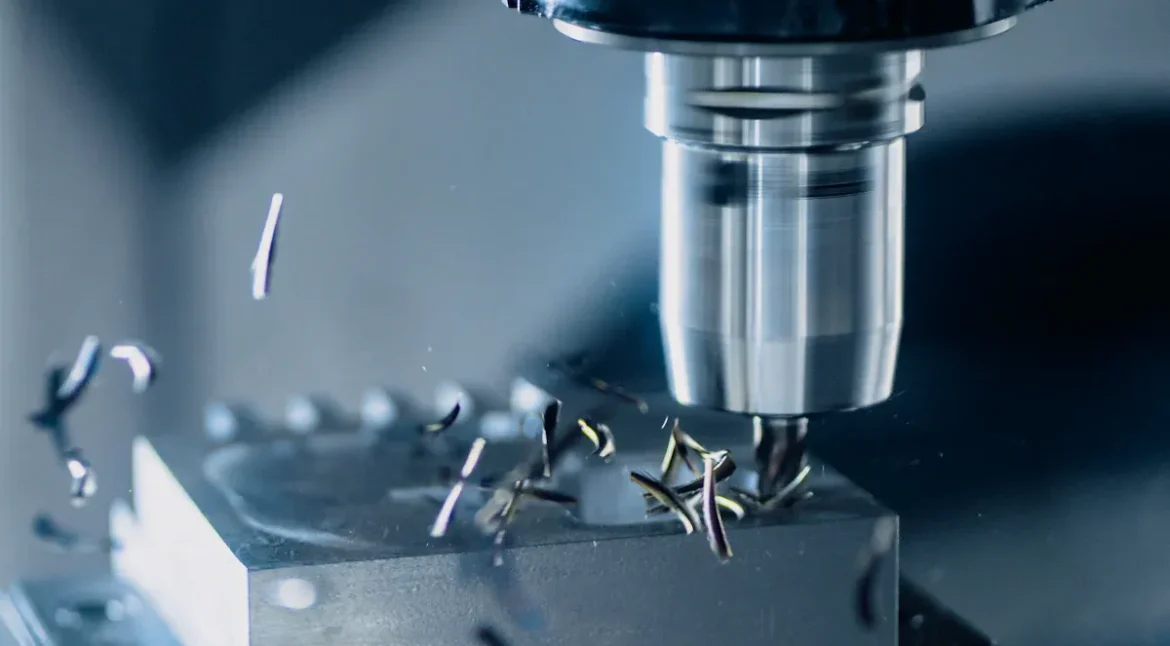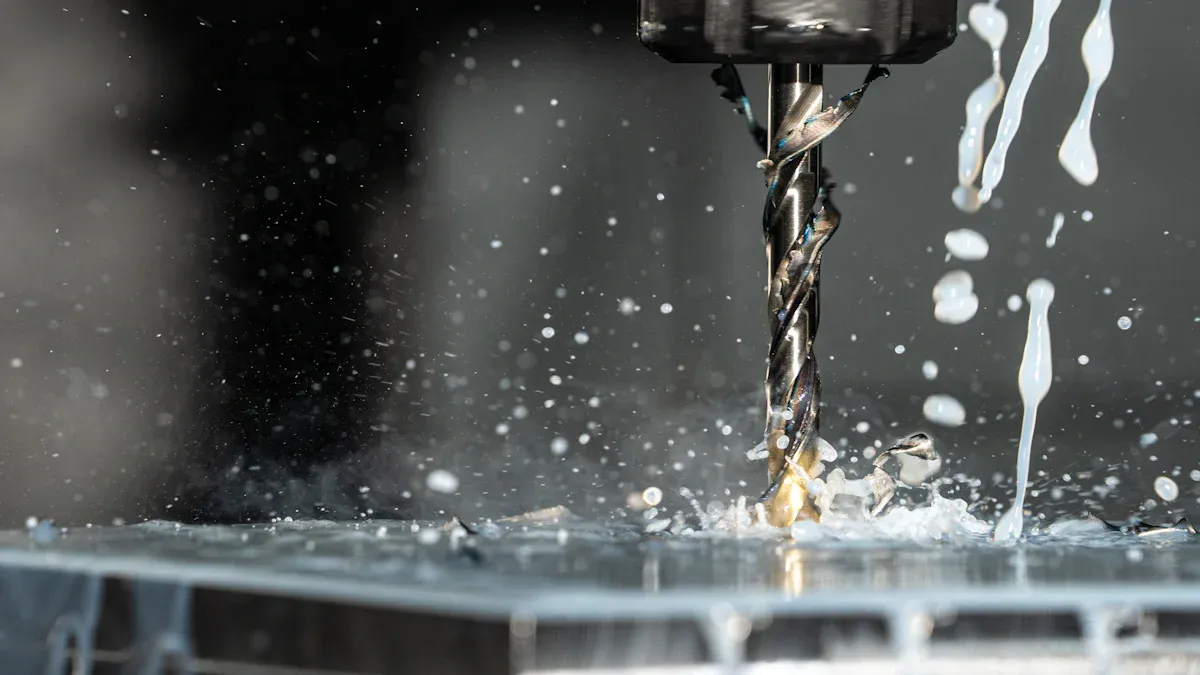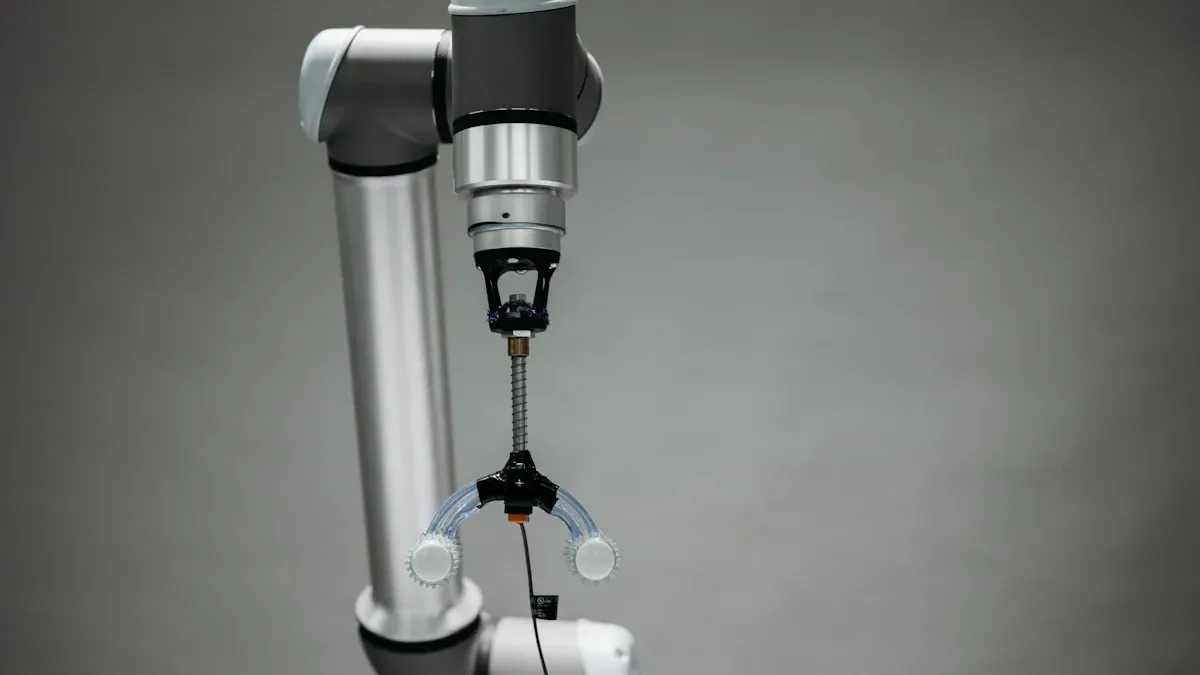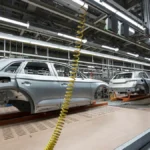The medical device industry relies on cnc machine parts to achieve exceptional precision and efficiency. These components play a crucial role in producing life-saving devices with unmatched accuracy. CNC machines perform diverse operations like milling, drilling, and engraving to create implants tailored to patients’ unique anatomies. Their error rates, often below 0.005%, ensure consistent quality for critical medical applications. With the global medical CNC machining market projected to surpass $6 billion by 2025, the demand for customizable and reliable solutions continues to grow. You can trust CNC machining to meet the highest safety and quality standards in healthcare.
Understanding CNC Machine Parts in Medical Devices
What is CNC machining?
CNC machining, or Computer Numerical Control machining, is a manufacturing process that uses pre-programmed software to control machinery. This technology enables the production of highly precise components by automating tasks like cutting, drilling, and milling. Unlike manual machining, CNC machining eliminates human error, ensuring consistent results. You can rely on this process to create intricate designs with tolerances as tight as ±0.002mm, making it ideal for medical applications.
Key advancements, such as AI integration and CAD/CAM software, have further enhanced the capabilities of CNC machining. These technologies allow for faster production and greater design flexibility. With the CNC machine tool market expected to grow by $21.9 billion between 2025 and 2029, the demand for high-precision components in sectors like healthcare continues to rise.
Why precision is critical in medical device manufacturing
Precision is the cornerstone of medical device manufacturing. Even the smallest deviation can compromise the safety and effectiveness of a device. CNC machining ensures that every component meets stringent specifications, reducing variability and improving reliability. For example, surgical instruments and implants require exact dimensions to function correctly and avoid complications.
The importance of precision becomes evident when considering performance metrics:
| Performance Metric | Importance |
|---|---|
| Compliance with stringent specifications | Ensures safety and effectiveness of medical devices in critical healthcare applications. |
| Improved part uniformity | Reduces variability, leading to better performance and reliability of medical devices. |
| Enhanced speed and efficiency | Increases production rates while maintaining quality, crucial for meeting healthcare demands. |
| Minimized human error | Reduces risks associated with manual processes, enhancing overall device safety. |
| Adherence to regulatory standards | Ensures devices meet necessary legal and safety requirements before market release. |
By prioritizing precision, you can ensure that medical devices perform as intended, providing patients with safe and effective solutions.
Regulatory compliance and quality assurance in CNC machining
Regulatory compliance is non-negotiable in the medical device industry. CNC machining must adhere to strict standards to ensure the safety and reliability of its components. Certifications like ISO 9001 and FDA regulations demonstrate a commitment to quality and compliance. These benchmarks guide manufacturers in meeting legal and safety requirements.
| Standard | Description |
|---|---|
| ISO 9001 | A globally recognized quality management system standard that demonstrates a company’s commitment to meeting customer demands and regulatory requirements. |
| ISO 14001 | A standard that guides organizations in minimizing environmental impact and improving environmental performance. |
You can trust CNC machining to meet these rigorous standards, ensuring that every part is manufactured to the highest quality. This commitment to compliance not only enhances product safety but also builds trust in the medical device industry.
Benefits of CNC Machine Parts for Medical Devices
High precision and consistency
CNC machine parts deliver unmatched precision and consistency, making them indispensable in medical device manufacturing. You can rely on CNC machining to produce components with tolerances as tight as ±0.002mm, ensuring every part meets exact specifications. This level of accuracy is critical for devices like surgical instruments and implants, where even minor deviations can lead to complications.
The automated nature of CNC machining eliminates human error, providing consistent results across large production runs. This consistency enhances the reliability of medical devices, ensuring they perform as intended in critical applications. Additionally, advanced technologies like 5-axis CNC machines allow for the creation of complex geometries with exceptional accuracy, further expanding the possibilities for innovation in healthcare.
Customization for patient-specific medical solutions
CNC machining excels in creating customized medical solutions tailored to individual patient needs. You can leverage this technology to produce implants, prosthetics, and surgical guides that match a patient’s unique anatomy. This level of customization improves patient outcomes and enhances surgical precision.
- The integration of advanced materials and precision machining techniques has revolutionized customization in medical manufacturing:
- High-performance polymers like PEEK are used to create biocompatible implants that mimic natural tissue properties.
- Precision machining ensures intricate medical plastic parts are produced with high accuracy, meeting the specific requirements of each patient.
- Custom polymer implants and surgical guides are now more accessible, thanks to CNC machining’s ability to handle complex designs efficiently.
By utilizing CNC machine parts, you can provide patient-specific solutions that not only improve functionality but also enhance the overall quality of care.
Rapid prototyping for accelerated innovation
CNC machining plays a pivotal role in accelerating innovation through rapid prototyping. You can quickly transform design concepts into physical prototypes, allowing for faster testing and iteration. This capability significantly reduces the time it takes to bring new medical devices to market.
Rapid prototyping with CNC machining offers several advantages:
- It enables you to test the functionality and fit of a design before committing to full-scale production.
- The process supports a wide range of materials, including metals and medical-grade plastics, ensuring prototypes closely resemble the final product.
- Iterative design improvements become more efficient, as CNC machining allows for quick adjustments and re-production of prototypes.
By embracing rapid prototyping, you can stay ahead in the competitive medical device industry, driving innovation while maintaining high standards of quality and safety.
Compatibility with biocompatible and durable materials
The compatibility of CNC machine parts with biocompatible and durable materials is a game-changer in medical device manufacturing. You can rely on CNC machining to work seamlessly with a wide range of materials that meet the stringent requirements of the healthcare industry. These materials not only ensure patient safety but also enhance the longevity and performance of medical devices.
Key Materials and Their Applications
CNC machining supports the use of advanced materials that offer unique benefits for medical applications. Here’s a closer look at some of the most commonly used materials:
| Material | Benefits | Applications |
|---|---|---|
| PTFE | Non-reactive, chemically resistant, and biocompatible | Surgical seals, implants, and low-friction components |
| PEEK | High strength, heat resistance, and excellent mechanical stability | Implantable components, diagnostic devices, and high-stress parts |
| UHMW-PE | Wear resistance and low moisture absorption | Joint replacements and surgical guides |
These materials are carefully selected to meet the demands of medical environments, where precision and reliability are paramount.
Metals for High-Performance Applications
CNC machining also excels in processing metals that combine strength, durability, and biocompatibility. You can trust these materials to deliver exceptional performance in critical medical applications:
- Stainless Steel: Known for its corrosion resistance and biocompatibility, it is widely used in surgical tools like forceps and hemostats, as well as in hip joint replacements.
- Titanium: This material offers unmatched strength and durability, making it ideal for bone replacements and prosthetics.
- Cobalt-Chrome: Renowned for its wear resistance, it is commonly used in high-stress implants such as knee and hip replacements.
These metals undergo precise machining to achieve the exact specifications required for medical devices, ensuring optimal functionality and patient safety.
Why Material Compatibility Matters
The compatibility of CNC machine parts with biocompatible and durable materials directly impacts the quality and effectiveness of medical devices. You can achieve the following benefits by leveraging this compatibility:
- Enhanced Safety: Biocompatible materials minimize the risk of adverse reactions, ensuring patient well-being.
- Improved Durability: Durable materials extend the lifespan of medical devices, reducing the need for frequent replacements.
- Versatility: CNC machining accommodates a wide variety of materials, enabling the production of diverse medical components.
By choosing the right materials and utilizing CNC machining, you can create medical devices that meet the highest standards of safety, reliability, and performance.
Applications of CNC Machine Parts in Medical Devices
Surgical instruments and tools
CNC machining plays a pivotal role in manufacturing surgical instruments and tools. You can rely on this technology to produce components with exceptional precision, ensuring that every instrument meets the exacting standards required for surgical procedures. Instruments such as scalpels, forceps, and retractors demand high accuracy to perform effectively and safely in critical medical environments.
The ability of CNC machines to achieve tolerances as tight as ±0.002mm ensures that surgical tools are not only sharp but also durable. This precision minimizes the risk of errors during surgery, enhancing patient safety. Additionally, CNC machining supports the use of biocompatible materials like stainless steel and titanium, which are essential for tools that come into direct contact with human tissue. These materials resist corrosion and maintain their integrity even after repeated sterilization cycles.
By leveraging CNC machining, you can produce surgical instruments that meet the highest standards of quality and reliability, ensuring optimal performance in life-saving procedures.
Orthopedic and dental implants
Orthopedic and dental implants require an unparalleled level of customization and precision, making CNC machining an ideal solution for their production. You can use CNC technology to create implants that perfectly match a patient’s anatomy, improving both functionality and comfort. For example, hip and knee replacements, spinal implants, and dental crowns all benefit from the high accuracy and consistency provided by CNC machining.
The process supports a wide range of materials, including titanium and cobalt-chrome, which are known for their strength, durability, and biocompatibility. These materials ensure that implants can withstand the stresses of daily use while remaining safe for long-term implantation. CNC machining also enables the creation of complex geometries, such as porous surfaces that promote bone integration, enhancing the stability of the implant.
By choosing CNC machining for orthopedic and dental implants, you can deliver patient-specific solutions that improve outcomes and quality of life.
Diagnostic and imaging equipment components
CNC machine parts are essential for producing components used in diagnostic and imaging equipment. You can depend on CNC machining to achieve the high precision and surface finishes required for devices like MRI machines, CT scanners, and X-ray equipment. These components must meet stringent technical parameters to ensure accurate and reliable diagnostic results.
Key Performance Metrics for Imaging Equipment Components
| Component Type | Technical Parameters | Benefits |
|---|---|---|
| MRI Machines | Tolerances as tight as ±0.0001 inches | Ensures accurate imaging |
| CT Scanners | Surface finishes of 16 Ra or better | Promotes smooth operation and longevity |
| X-ray Equipment | High precision in component production | Critical for reliable diagnostic results |
CNC machining ensures that these components meet the exact specifications required for optimal performance. For example, the tight tolerances achieved in MRI machine components enhance imaging accuracy, while the smooth surface finishes in CT scanner parts reduce wear and extend the equipment’s lifespan. This level of precision and reliability is crucial for patient care in medical diagnostics.
By utilizing CNC machining, you can produce diagnostic equipment components that meet the highest standards of quality, ensuring accurate and efficient medical imaging.
Micro-machined parts for minimally invasive procedures
Minimally invasive procedures have revolutionized modern medicine, offering patients faster recovery times, reduced pain, and lower risks of complications. These procedures rely heavily on micro-machined parts, which are essential for creating the small, precise components required for advanced medical tools and devices. CNC machining plays a pivotal role in producing these parts with unmatched accuracy and consistency.
Micro-machining enables the creation of high-precision components that meet the stringent demands of minimally invasive techniques. You can achieve tight tolerances and intricate geometries that are critical for tools like catheters, endoscopes, and robotic surgical instruments. The ability to produce such detailed parts ensures that medical devices perform flawlessly during delicate procedures.
Why CNC machining is indispensable for micro-machined parts
CNC machining stands out as the most reliable method for manufacturing micro-machined parts. Its advanced capabilities allow you to produce components with exceptional precision, even at a microscopic scale. This level of accuracy is vital for minimally invasive procedures, where every millimeter matters.
- Key advantages of CNC machining for micro-machined parts:
- It achieves tight tolerances, ensuring components fit perfectly within complex medical devices.
- It supports the production of intricate designs, such as channels and grooves, which are essential for fluid delivery systems.
- It ensures consistency across production runs, maintaining the reliability of medical tools.
For example, robotic surgery systems depend on CNC-machined parts to function with precision. These systems require components with complex geometries and smooth finishes to operate seamlessly. CNC machining delivers these specifications, enabling surgeons to perform procedures with greater accuracy and control.
Materials used in micro-machined parts
The materials used for micro-machined parts must meet the highest standards of biocompatibility and durability. CNC machining supports a wide range of materials, allowing you to select the best option for your specific application.
| Material | Benefits | Applications |
|---|---|---|
| Stainless Steel | Corrosion-resistant and biocompatible | Surgical instruments and robotic components |
| Titanium | Lightweight, strong, and biocompatible | Implants and precision surgical tools |
| PEEK | High-performance polymer with biocompatibility | Catheters and minimally invasive device parts |
These materials ensure that micro-machined parts can withstand the demands of medical environments while maintaining patient safety.
The impact of micro-machined parts on patient care
Micro-machined parts enhance the effectiveness of minimally invasive procedures by improving the performance of medical devices. You can trust these components to deliver the precision and reliability needed for successful outcomes. For instance, micro-machined parts in endoscopic tools allow for better visualization and maneuverability, enabling surgeons to perform complex procedures with minimal disruption to surrounding tissues.
By leveraging CNC machining, you can produce micro-machined parts that meet the highest standards of quality and innovation. These components not only advance medical technology but also improve the overall patient experience, making minimally invasive procedures safer and more effective.
Challenges and Limitations of CNC Machine Parts
Material constraints in biocompatible options
Biocompatible materials are essential for medical devices, but their availability and machinability present challenges. You may find that materials like titanium and PEEK, while highly suitable for implants and surgical tools, are expensive and difficult to machine. Titanium, for instance, requires specialized cutting tools and techniques due to its hardness and heat resistance. These factors increase production time and costs.
Additionally, not all biocompatible materials are compatible with CNC machining. Some polymers and composites may degrade under the heat and stress of the machining process. This limits your material choices, especially when designing innovative medical devices. To overcome these constraints, you must carefully balance material properties with machining capabilities, ensuring the final product meets both performance and safety standards.
Production speed for large-scale manufacturing
CNC machining excels in precision but faces limitations in production speed, especially for large-scale manufacturing. You may encounter challenges when optimizing cutting speeds and feed rates to balance efficiency and quality. A conservative cutting velocity, while ensuring accuracy, can slow down production and increase setup times.
| Evidence Description | Key Insight |
|---|---|
| The profit speed should choose between the speeds for optimum cutting and production rate. | A conservative cutting velocity may hinder efforts to reduce setup and trial cycle time, indicating a direct link to production speed challenges. |
| Practical constraints must be considered when optimizing unit manufacturing costs. | CNC machines can operate within specified limits to determine optimal cutting conditions, which affects production speed. |
These constraints highlight the complexity of achieving optimal production rates without compromising quality. You may need to invest in advanced CNC systems or automation to address these challenges, but this can further increase costs.
Cost implications for complex designs
Complex designs in medical devices often lead to higher production costs. You may face increased expenses due to material waste, skilled labor, and equipment maintenance. For example, machining titanium can result in 30–70% material waste, significantly impacting overall costs. Skilled operators, earning $20–$40 per hour, may require 2–5 hours to produce a single complex part.
| Cost Factor | Description |
|---|---|
| Material Costs | High waste (30–70% removed), e.g., $50/kg for titanium. |
| Labor Costs | Skilled operators; $20–$40/hour, 2–5 hours per part for complex shapes. |
| Equipment Costs | CNC machines cost $50,000–$500,000; maintenance is 5–10% annually. |
These factors make it crucial for you to evaluate design complexity against production feasibility. While CNC machining offers unparalleled precision, the cost implications of intricate designs require careful planning to ensure profitability and efficiency.
Future Trends in CNC Machine Parts for Medical Devices
Integration of automation and AI in manufacturing
Automation and artificial intelligence (AI) are transforming the way you approach CNC machining for medical devices. These technologies enhance efficiency, precision, and reliability in manufacturing processes. By integrating robotics, you can achieve faster production cycles while maintaining consistent quality. AI-driven quality control systems help identify defects early, reducing errors and waste. Predictive maintenance tools also allow you to anticipate equipment failures, minimizing downtime and ensuring uninterrupted production.
Emerging technologies like digital twin systems provide real-time monitoring and optimization of manufacturing processes. These virtual replicas of physical systems enable you to test and refine operations without disrupting actual production. Additionally, AI-powered design software optimizes tool paths, improving accuracy and reducing machining time. With these advancements, you can stay ahead in the competitive medical device industry by delivering high-quality products faster and more efficiently.
Advancements in biocompatible and composite materials
The development of advanced materials is revolutionizing the production of cnc machine parts for medical devices. Materials engineering now focuses on creating biocompatible options that ensure safety and functionality. Titanium and cobalt-chromium alloys are widely used for their strength, corrosion resistance, and compatibility with human tissues. These materials are ideal for implants and surgical tools that require durability and precision.
Composite materials are also gaining traction. By combining the best properties of different substances, composites offer improved wear resistance, tensile strength, and functionality. For example, dental implants benefit from materials that withstand high stress while maintaining biocompatibility. These advancements allow you to create medical devices that meet the highest standards of performance and safety, ensuring better outcomes for patients.
Hybrid manufacturing with CNC machining and 3D printing
Hybrid manufacturing combines the strengths of CNC machining and 3D printing, offering you unparalleled design freedom and efficiency. This approach allows you to create intricate parts by leveraging the speed of 3D printing and the precision of CNC machining. For instance, 3D printing can quickly produce complex internal structures, while CNC machining provides detailed finishing for critical surfaces.
| Advantage | CNC Machining | 3D Printing |
|---|---|---|
| Efficiency | High precision but slower | Rapid prototyping |
| Complexity of Geometries | Limited to simpler shapes | Capable of complex internal structures |
| Material Utilization | Subtractive, potential waste | Additive, high material utilization |
| Production Cycle | Longer due to tooling | Shorter, can be done in one step |
| Cost Effectiveness | Higher initial tooling costs | Reduces tooling needs, lowers costs |
By integrating these methods, you can maximize material savings, shorten production cycles, and reduce costs. Hybrid manufacturing also minimizes errors since the 3D-printed part remains within the build envelope throughout the process. This innovative approach enables you to produce complex medical components with greater efficiency and precision, paving the way for the next generation of medical devices.
Enhanced precision through next-generation CNC technology
Next-generation CNC technology is redefining precision in medical device manufacturing. You can now achieve unparalleled accuracy and efficiency by leveraging advancements in artificial intelligence (AI), automation, and smart factory systems. These innovations ensure that every component meets the exact specifications required for critical healthcare applications.
AI-driven CNC machines are transforming machining processes. They analyze vast amounts of data to refine operations, predict equipment failures, and reduce rejection rates. This proactive approach minimizes downtime and ensures consistent quality. For example, smart sensors embedded in CNC systems monitor real-time data, allowing you to optimize production workflows and improve part accuracy. These sensors also detect anomalies early, preventing defects before they occur.
Tip: Incorporating AI-driven quality assurance systems can significantly reduce waste and improve product reliability.
Automation and robotics integration further enhance precision. Collaborative robots, or cobots, work alongside CNC machines to streamline manufacturing tasks. These robots handle repetitive operations with exceptional accuracy, freeing you to focus on complex designs and innovations. IoT-enabled smart factories take this a step further by connecting machines and systems for seamless communication. Real-time monitoring ensures that production remains efficient and error-free.
Key Metrics of Enhanced Precision
| Technology | Benefit |
|---|---|
| AI and Machine Learning | Improves accuracy and reduces rejection rates. |
| Advanced Automation & Robotics | Enhances efficiency and precision in repetitive manufacturing tasks. |
| IoT-Enabled Smart Factories | Optimizes workflows and minimizes unexpected downtime. |
By adopting next-generation CNC technology, you can push the boundaries of medical device manufacturing. These advancements not only improve precision but also accelerate production, ensuring that life-saving devices reach patients faster and with greater reliability.
CNC machine parts form the backbone of the medical device industry, delivering unmatched precision and reliability. Their role in producing life-saving devices highlights their importance in healthcare. Advancements in technology, such as the integration of additive manufacturing, enable you to create customized implants tailored to individual needs. The CNC machining market is projected to grow from $95 billion to $154 billion by 2032, with a compound annual growth rate of 5%. This growth underscores the sector’s bright future, where innovation continues to drive safer and more effective medical solutions.






